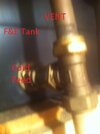- Joined
- 5 Sep 2024
- Messages
- 6
- Reaction score
- 0
- Country

I’m hoping for some advice regarding a somewhat “unique” heating system, but appreciate this might be a bit of an odd one!
I’m familiar with S plan, Y plan, even W and C plan. This is not that...
Essentially it is an non-condensing traditional heat only oil boiler (no internal pump) with four tapping ports on the water jacket.
Two of those boiler ports are used for CH flow and return, circulated by one pump which feeds an open vented UFH system (that’s probably a topic for another day).
The other two boiler ports go around the water cylinder, circulated by a second pump.
It’s not a converted gravity system, just a straight loop.
I suppose a bit like a pump plus system, but made from two entirely separate pumps directly from the boiler.
No NRVs. No motorised valves. Pumps are controlled via relays.
It has been in for long while, and obviously works as far as stuff gets hot. But it has some issues on the CH side.
Ripping it all out and starting from scratch isn’t an option, but some amendments are going to have to be made.
My question is, I know it is unconventional, but are there any glaringly obvious problems with leaving the HW part of the system as it is?
I was wondering if the boiler itself will act almost like a low loss header to provide sufficient hydraulic separation between the pumps?
I’m familiar with S plan, Y plan, even W and C plan. This is not that...
Essentially it is an non-condensing traditional heat only oil boiler (no internal pump) with four tapping ports on the water jacket.
Two of those boiler ports are used for CH flow and return, circulated by one pump which feeds an open vented UFH system (that’s probably a topic for another day).
The other two boiler ports go around the water cylinder, circulated by a second pump.
It’s not a converted gravity system, just a straight loop.
I suppose a bit like a pump plus system, but made from two entirely separate pumps directly from the boiler.
No NRVs. No motorised valves. Pumps are controlled via relays.
It has been in for long while, and obviously works as far as stuff gets hot. But it has some issues on the CH side.
Ripping it all out and starting from scratch isn’t an option, but some amendments are going to have to be made.
My question is, I know it is unconventional, but are there any glaringly obvious problems with leaving the HW part of the system as it is?
I was wondering if the boiler itself will act almost like a low loss header to provide sufficient hydraulic separation between the pumps?

